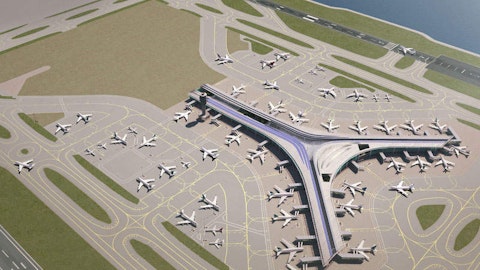Corporación América Airports S.A. (NYSE:CAAP) Q3 2023 Earnings Call Transcript November 16, 2023
Operator: Good morning and welcome to the Corporacion America Airports Third Quarter Conference Call. A slide presentation accompanies today’s webcast and is available in the Investor section of the Corporacion America Airports website. As a reminder, all participants are in a listen-only mode. There will an opportunity to ask questions at the end of the presentation. At this time, I would like to turn the call over to Patricio Inaki Esnaola, Head of Investor Relations. Patricio, please go ahead.
Patricio Inaki Esnaola: Thank you. Good morning, everyone, and thank you for joining us today. Speaking during today’s call will be Martin Eurnekian, our Chief Executive Officer; and Jorge Arruda, our Chief Financial Officer. Before we proceed, I would like to make the following Safe Harbor statement. Today’s call will contain forward-looking statements, and I refer you to the forward-looking statements section of our earnings release and recent filings with the SEC. We assume no obligation to update or revise any forward-looking statements to reflect new or changed events or circumstances. I will now turn the call over to our CEO, Martin Eurnekian.
Martin Antranik Eurnekian: Thank you, Inaki. Hello, everyone, and welcome to our third quarter 2023 earnings call. I will start today’s call with an overview of key highlights, followed by a review of traffic and cargo trends. I will then hand it over to Jorge for an overview of our third quarter financial results. We delivered another strong quarter with a robust performance across the business. Revenues ex-IFRIC12 increased 37% compared to third quarter 2019 and adjusted EBITDA set another record high at $173 million, up 73% compared to a third quarter of 2019 even with passenger traffic at 2% below pre-pandemic levels. Adjusted EBITDA margin ex-IFRIC12 expanded 8.6 percentage points to 40.9% as we continue to drive operating gains.
This good performance was supported by positive adjusted EBITDA growth across all geographies, reflecting our sustained focus on efficient execution together with the continued recovery in travel demand. In addition, we closed the quarter with a strong balance sheet and a comfortable maturity profile. Our leverage ratio improved further this quarter, achieving an all-time low of 1.6 times on the back of higher profitability and a slight reduction in net debt. We are also making good progress in the execution of our fully funded investment programs in Argentina and Uruguay. Additionally, we continue to work on new airport investment opportunities and remain focused on delivering long-term value to our stakeholders. Please turn to slide four for the discussion on traffic.
By September, overall, traffic had recovered to 99% of pre-pandemic traffic levels, with international passenger traffic surpassing third quarter of 2019 levels by 5%. This performance was supported by a continued recovery in travel demand reflected by higher load factors and the gradual return of flight routes and frequencies across all countries of operation. On a geographic basis, traffic volumes in Italy surpassed pre-pandemic levels for the first time this quarter, while Armenia and Ecuador continued to beat 2019 volumes. In turn, passenger traffic in Argentina and Uruguay remained in line with third quarter of 2019 levels, while traffic in Brazil continues on the path to full recovery. Armenia continues to lead the recovery supported by the entrance of new carriers and increased flight frequencies.
Traffic was up 40% year-on-year, beating pre-pandemic levels for the sixth consecutive quarter. This solid performance continued into October with traffic surpassing pre-pandemic levels by 62%. In Argentina, passenger traffic increased to nearly pre-pandemic levels even as we experienced a minor contraction from the second quarter of 2023, which benefited from PreViaje, a government-sponsored program to boost domestic tourism. Domestic traffic, which accounted for more than 70% of total traffic remained strong, beating pre-pandemic levels by 4%, while international passengers recovered to 89% of third quarter of 2019 levels. In October, total traffic exceeded 2019 levels by 10%, with domestic traffic surpassing pre-pandemic numbers and international traffic improving to 96% of 2019 volumes.
In Ecuador, solid performance in both domestic and international traffic, driven mainly by increased frequencies, supported the sustained growth trend in passenger traffic, which was 12% above pre-pandemic levels. Growth continued into October, beating 2019 volumes by 9%. Uruguay continued to recover with the number of passengers increasing to 94% of third quarter of 2019 levels. This good performance continued into October as passenger traffic surpassed 2019 volumes by 7%. Passenger traffic in Italy beat pre-pandemic levels for the first time, up 4% from third quarter of 2019 volumes, supported by growth in the high teens in international traffic and low single digit in domestic traffic. While some destinations have not yet resumed at Pisa Airport, Florence Airport continued to operate above pre-pandemic levels, increasing in the mid-teens from the third quarter of 2019 levels.
In October, traffic exceeded 2019 levels by 6%. Finally, traffic in Brazil was at 94% of pre-pandemic levels compared to 96% in the previous quarter as some local airlines remain impacted by financial and aircraft constraints. October traffic was 15% below 2019 levels, still impacted by the aforementioned financial and aircraft constraints. Moving onto cargo on slide five. We are pleased to observe a sustained recovery in our cargo business. Volumes were up 13% year-on-year to 93% of pre-pandemic levels, compared to 86% in the prior quarter. Cargo revenues in turn were 56% higher than the third quarter of 2019 levels, with all geographies beating pre-pandemic levels except Brazil, which still remains in a recovery phase. I will now hand off the call to Jorge, who will review our financial results.
Please, Jorge, go ahead.
Jorge Arruda: Thank you, Martin and good day everyone. Starting with our top-line on slide six. As Martin stated, we are pleased with the third quarter results. Total revenues ex-IFRIC increased 22% year-on-year and surpassed pre-pandemic levels by 37%. The strong trends we have seen throughout the year continued in this quarter in both aeronautical and commercial segments of our business. Aeronautical revenues were up 27% year-on-year and surpassed pre-pandemic levels by 17%, mainly supported by tariff increases and the sustained recovery in passenger traffic across our airport network. Argentina, Armenia, Uruguay and Brazil maintained strong momentum with aeronautical revenues up double-digits year-on-year and also when compared to third quarter 2019.
Commercial revenues, which accounted for 48% of our total ex-IFRIC revenues in the quarter were up 16% year-on-year and 65% above pre-pandemic levels. The solid growth in carbon — revenues in Argentina, higher fuel-related revenues in Armenia and VIP lounges in Brazil were the main drivers behind this group performance. Notably, compared to 2019 levels, we have achieved strong commercial revenue growth well above passenger traffic growth, resulting in a 40% increase in revenues per tax to $19 this quarter from $13.6 in the third quarter of 2019. Turning to slide seven, total costs and expenses for the quarter increased 13% year-on-year ex-IFRIC12, reflecting the sustained growth of our business. But at the same time remains well below the 22% growth in revenues and 19% growth in passenger traffic.
Compared to 2019, total costs and expenses ex-IFRIC12 were up 18%. The primary factors were higher fuel costs in Armenia due to increased fuel sales, while in Argentina we experienced higher concession fees tied to increased activity and higher salaries as the local inflation rate was above currency depreciation. SG&A expenses increased 9% year-on-year also well below the 22% revenue growth compared to third quarter 2019. SG&A was down 25%, mainly reflecting the easier comparison from the impact of bad debt charge of $23 million in Argentina, recording the third quarter of 2019. Moving onto profitability on slide eight, our robust top-line growth coupled with our strong focus on cost control continued to support improved profitability. As a result, the third quarter 2023 adjusted EBITDA reached $173 million, setting another record and surpassing the historical highs achieved in the first two quarters of the year.
Year-on-year adjusted EBITDA was up 32% with strong contributions from Argentina, Armenia and Italy and the adjusted EBITDA margin, ex-IFRIC12 expanded 3.2 percentage points to 40.9% in this quarter. Compared to 2019 levels, adjusted EBITDA include 73% or 40% when excluding the bad debt charge recorded in the third quarter 2019. Turning to slide nine, we closed the quarter with a total liquidity position of $558 million, up $106 million when compared to year-end 2022, reflecting our sustained strong cash flow generation. Notably, all our operating subsidiaries reported positive cash flow from operating activities in the third quarter. Moving onto debt and maturity profile on slide 10. Total debt at quarter end was $1.42 billion, while our net debt decreased to $955 million from $1.1 billion at year end 2022.
We closed the quarter with a strong balance sheet and a healthy debt profile with no significant maturities in the next four quarters. Consistent with our last quarter. As a result of the continued growth of our adjusted EBITDA and lower debt levels. Our net leverage ratio decreased further to 1.6 times from 2.4 times at December 2022, achieving another all-time low. In sum, we delivered robust operating and financial results, further reducing our leverage and strengthening our financial position to support future growth opportunities. I will now hand the call back to Martin who will provide closing remarks and discuss our view for the remainder of the year.
Martin Antranik Eurnekian: Now wrapping up. Please turn to slide 12. We are pleased to have reported a strong third quarter, achieving a new record high adjusted EBITDA and the margin expanded 8.6 percentage points versus the same period of 2019 or 1.1 percentage points when excluding the bad debt charge recorded in the third quarter of 2019. We are achieving these good results even though traffic volume is still a bit below pre-pandemic levels. Also noteworthy is a considerable increase in revenues per passengers which increased 40% to $19 this quarter from $13.6 in the third quarter of 2019. Looking ahead, we remain focused on advancing in the negotiations with the government of Armenia regarding a $400 million CapEx program.
The approval process for the new master plan at Florence airport which continued to advance, and on receiving the indemnification payment related to the return of Natal Airport within the next few months. We are also focused on expanding our network and making continuous progress with the Government of Nigeria regarding the Abuja and Kano concession agreements. In terms of travel dynamics, we remain cautiously optimistic as we are monitoring the macroeconomic environment in Argentina, a concession we have successfully managed across many different cycles and challenges over the past 20 years. We also maintain a positive view on Armenia, Italy, Brazil and Uruguay. On the financial front, we are supported by and benefit from a solid balance sheet and efficient operations in each of our operating subsidiaries.
This ends our prepared remarks. We are ready to take your questions. Operator, please open the line for questions.
See also 10 Biggest Lottery Jackpots of All Time and 12 Best Real Estate Stocks To Invest In.
Q&A Session
Follow Citizens Capital Corp (OTCMKTS:CAAP)
Follow Citizens Capital Corp (OTCMKTS:CAAP)
Operator: Thank you. Ladies and gentlemen, we will now begin the question-and-answer session. [Operator Instructions] Our first question comes from the line of Fernanda Recchia from BTG. Please go ahead.
Fernanda Recchia: Hello. Thank you for taking my question and congrats on the result. Two questions here on our side. First, I wanted to further explore a little bit traffic trend. We saw that traffic has been posting double-digit growth. And as Martin mentioned in his initial remarks, Armenia has been the main outperformer. So just wondering if you could provide us some color on the trends that you are anticipating for next year and next month. Maybe if could give some comments by region it would be very helpful. And second, I just wanted to get your latest update on the Natal Airport. I know that Martin mentioned that the negotiations are going, but I think that the latest timeline we had was November for the devolution. So just wondering if this timeline is the latest one or if you have any updates regarding this. Thank you.
Jorge Arruda: Hi, Fernanda. This is Jorge. Thank you so much for your questions as well as your comments. So regarding traffic trends, as you correctly pointed out, Armenia has been leading the growth. Year-to-date, they are up 53% versus last year and perhaps although still growing and still actually relatively good growth. But on the other spectrum within our portfolio is Brazil with plus 10% versus last year. So we remain positive and constructive going forward. We — this year consider that we are still in the final stages of recovering what we had lost during the COVID. So going ahead, what we expect is a more normal growth, if you will. But we are very constructive and have very positive feelings in some of our airport portfolios in our company.
Armenia being one of them. Toscana, we are very constructive in Brazil. In Argentina obviously, there are elections upcoming and you know, we have to wait and see what are going to be the financial measures by the new government, et cetera. But as Martin said, we have gone through many, many crises and you know, always have managed to perform well during the many, many crises we went through. So, in summary, we are constructive. Regarding Natal, the government, and by that I mean the Ministry of Ports and Airports and the Minister of Finance requested the necessary amendments, if you will to the budget law. To the Congress to include this indemnification payment, it has been sent several weeks ago to the Congress. It’s a normal procedure, given the restrictions that exist in the budget law in Brazil, and the government expects within the next few weeks to receive that.
And it’s within perhaps a week following the receipt of the approval by the Congress of this amendment to the budget. The payment would be made to us and then Zurich would make their part. So, in summary, we expect our indemnification payment to be paid in two installments. First, by the government, and second by Zurich within a matter of few days between one and the other. The Minister told me that they expect this process to be concluded by year-end. We’ll continue to update the market as we hear from the government.
Fernanda Recchia: Perfect. Jorge, thank you very much for your answers. Have a good day.
Jorge Arruda: Thank you.
Operator: [Operator Instructions] We have our next question coming from the line of Stephen Trent from Citi. Please go ahead.
Stephen Trent: Good morning, everybody, and thanks for taking my questions. Just one for me and one follow-up as per your rules. Could you refresh my memory on CapEx, you know, where you think the long-term maintenance number is going to be, given that your CapEx today seems very low versus historical levels? And two, with runoff elections in Argentina in the pipeline, are you at this very early stage seeing any kind of major policy differences with respect to airports or aviation of the different candidates? Thank you.
Martin Antranik Eurnekian: Hello, Stephen. Martin here. I will address your second question first and then I will pass it on to Jorge for the second one. So, regarding elections in Argentina, it’s still very uncertain. Although we are very, very close, it’s really uncertain the outcome of the elections and with the outcome also understanding the possible policy changes. So we are looking at this with caution and expecting to engage with whoever the new government is. If the government remains with the official party, most probably we wouldn’t see huge differences from what we’ve seen so far. If it changes color, then we have to understand what the government possible policies are. We have been in touch with everybody before, but too early to say if there will be a strong policy shift.
We are cautiously optimistic still on the outcome of any candidate in the elections for our sector, which is growing a lot. And I think all candidates agree that tourism is one of the key pillars for Argentina’s growth and Argentina’s ability to bring in foreign currency into the country. So we expect any candidate to support primary growth of tourism, which is core for our industry. So I’ll pass it on to Jorge now regarding maintenance CapEx going ahead.
Jorge Arruda: Thank you, Martin. Hi, Steve. How are you? Thanks for your question. Jorge speaking.
Stephen Trent: Thank you, Jorge.





